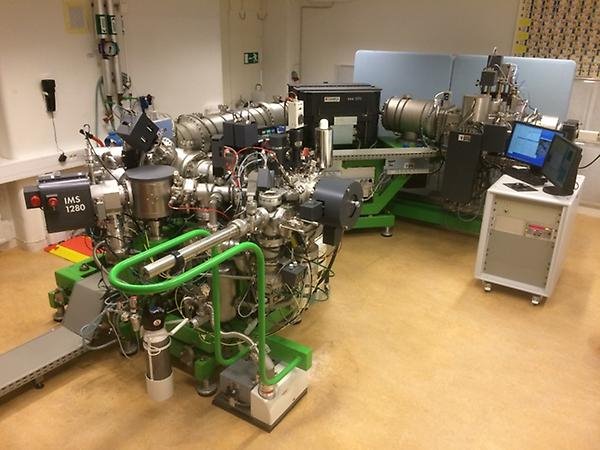Early planetary evolution – a microanalytical perspective

NordSIMS’ CAMECA IMS1280 instrument used for most of the project research.
Summary
In the last few years, the idea that the Earth and Moon share a common early history is gaining increasing recognition by the scientific community. This concerns not only models for the origin of the Moon by the Giant Impact (i.e collision of a Mars size body with proto-Earth) which can explain close similarities in their chemical and isotopic compositions, but also a remarkable match in the nature of magmatic processes that shaped the early history of the two planetary bodies and their history of bombardment by projectiles of different sizes.
It is clear that answers to a significant number of questions related to the early history of the Earth can be found on the Moon, where internal activity was extinguished very early preserving the first stages of planetary evolution that have been erased on the accessible Earth by over four billion years of active plate tectonics.
The current project bridges the gap between lunar and terrestrial geology by applying essentially the same analytical methods to samples from both bodies. Of key importance is the mineral zircon, the only extant remnant of the Earth prior to 4 Ga (zircon <4.4 Ga is found in sediments from western Australia) and present on the Moon with ages up to 4.5 Ga in regolith soils. Zircon and its microscopic mineral inclusions will be studied using a wide variety of in situ analytical methods targeted to understanding its formation in melts and what it can tell us about its parent magma, constrained by parallel study of in situ zircon in some of Earth’’s earliest preserved rocks from ca. 3.8 – 4.0 Ga.
A second aspect of this project focuses on lunar basalts, samples of the mantle of the Moon (and, by analogy, the long-lost early mantle of the Earth). Using a newly developed in situ Pb-isotope analytical protocol, our work is providing new dates of unprecedented precision for the lunar basalt suite (both Apollo samples and meteorites) and helping to constrain both lunar mantle reservoir evolution and the presently poorly known age of the Moon. These results will not only constrain early magmatic processes on the moon but will be of direct relevance to the early earth.
A third sub-project involves the study of rare meteorites from Mars, analysis of which is being used to constrain the chemical geodynamics of the planet, from its earliest formation and differentiation studied by Pb isotopes through to surface reservoir interactions studies by O- and Cl- isotopes and halogen contents.
This project is funded by the Knut and Alice Wallenberg Foundation and the Swedish Research Council (VR)
Project participants at the museum
- Martin Whitehouse (principle investigator)
- Gavin Kenny
External project participants
- Jeremy Bellucci, Sweden
- Alexander Nemchin (co- principle investigator), Curtin University, Australia
- Joshua Snape, Free University, Amsterdam, The Netherlands
Selected publications
- Bellucci, J.J., Whitehouse. M.J., John, T., Nemchin, A., Snape, J., Bland, P., Benedix-Bland, G. (2017). Halogen and Cl isotopic systematics in Martian phosphates; Implications for the Cl cycle and surface halogen reservoirs on Mars. Earth and Planetary Science Letters 458, 192-202.
- Sarafian, A.R., John, T., Roszjar, J., Whitehouse, M.J. (2017). Chlorine and hydrogen degassing in Vesta's magma ocean. Earth and Planetary Science Letters 459, 311-319.
- Roszjar, J, Whitehouse, M.J., Srinivasan, G., Mezger, K., Scherer, E.E., Van Orman, J.A., Bischoff, A. (2016). Prolonged magmatism on 4 Vesta inferred from Hf–W analyses of eucrite zircon. Earth and Planetary Science Letters, 452, 216-226. doi: 10.1016/j.epsl.2016.07

- Snape, J.F., Nemchin, A.A., Bellucci, J.J., Whitehouse, M.J., Tartèse, R., Barnes, J.J., Anand, M., Crawford, I.A. (2016). Lunar basalt chronology, mantle differentiation and implications for determining the age of the Moon. Earth and Planetary Science Letters, 451, 149-158.
- Nemchin, A.A., Humayun, M., Whitehouse, M.J., Hewins, R.H., Lorand, J.-P., Kennedy, A., Grange, M., Zanda, B., Fieni, C., Deldicque, D. (2014). Record of the ancient martian hydrosphere and atmosphere preserved in zircon from a martian meteorite. Nature Geoscience,7, 638-642
More information on sub-projects
- Constraining the magmatic evolution of the Moon with Pb isotope measurements of lunar basalts
- Constraining the flux of impact cratering in the inner Solar System with lunar breccias


